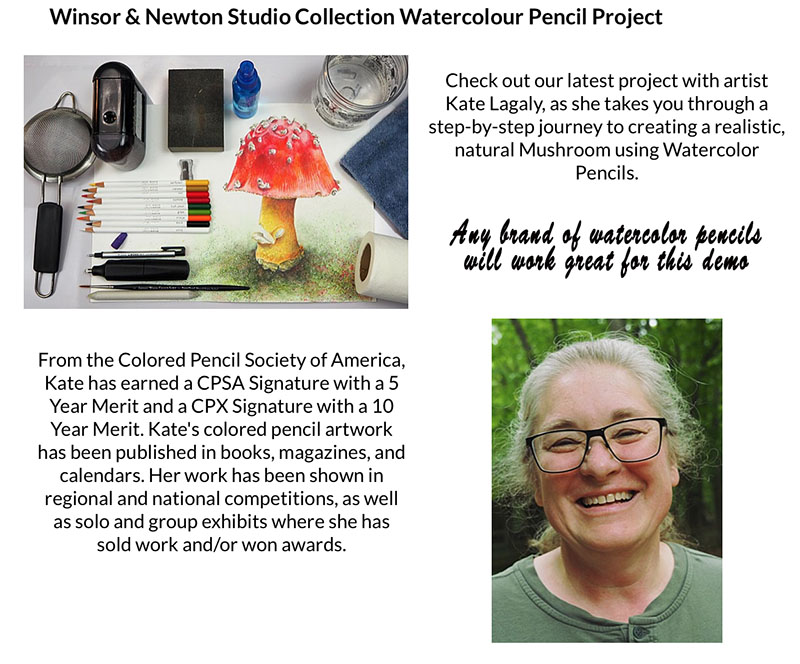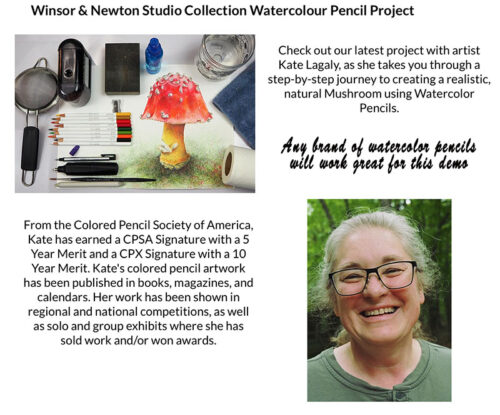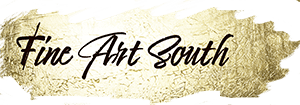This Watercolor Pencil Demo is a simplistic form of using watercolor pencils, but it’s great for people of all skill levels with watercolor because it gets you back to basics. Even if you are well-versed in watercolor methods, flexing your skills in a new way can make you look at your methods in a new light. If you are a beginner or want to try watercolors, it’s a good way to start. So much of watercolor painting can be somewhat scary to new artists because it seems so uncontrolled. Using watercolor pencils is a way to regain a lot of that control. You use them as you would use pencils or markers, and then where you want to (and if you want to) you can add water, which transforms your pencil drawing into a watercolor painting. Try them and have some fun! (Non-disclaimer disclaimer: I make absolutely nothing from Winsor and Newton and this is not an endorsement of their brand. You can use this demo method with any brand of paper or watercolor pencils and in fact I have good watercolor pencils in other brands).

The demo below is from the ArtistsNetwork.
Go there for the entire demo.
Watercolor Pencils: The Best of Both Worlds
Create a colorful red-cap mushroom using Winsor & Newton Studio Collection Watercolour Pencils, a tool that offers tremendous versatility. Plus, they’re fun!
By Kate Lagaly CPSA, CPX
Speaking of color-mixing, try this: Use one of the pencils to lay down color on a non-porous surface and then add water. You can do this with several colors and mix a gorgeous palette. These pencils are highly pigmented, so you can lay down lots of brilliant color with little effort, creating stunning drawings or watercolor effects.
You won’t have to worry about breakage, either, because Winsor & Newton Studio Collection Watercolour Pencils are made with break-resistant cores and points. No more panicking if you drop your pencil!
Another great benefit is that the pencils are perfectly portable, which makes them a great tool for painting en plein air or taking along with you on your travels.
Now, let’s put them to work!
In the following demo, you can see how I created an adorable red-cap mushroom using the pencils.
Gather Your Supplies
Watercolor Pencils: This demo uses the Winsor and Newton brand of pencils (use whatever brand you prefer)
Watercolor Paper: (use a watercolor block of 140 lb. paper, hot press, the brand you prefer) You will be happier with professional quality paper. The cheap stuff is cheap for a reason.
Erasers: Pencil top eraser, battery-powered eraser, or erasers of your choice
Brush: Use a brush of your choice
Additional supplies:
- Water container, a small fine mist spray bottle, paper towels, small washcloth or hand towel
- Drawing stump and sanding block or sandpaper to clean the stump
- Small metal strainer, sanding block, or sandpaper to make the watercolor pencil texture
Step 1: Draw the Mushroom
To begin, I sketched the mushroom onto the watercolor paper.
Step 2: Add Color
Working on dry paper, I used the red and sunflower pencil colors to apply color to the cap and stem. Use an eraser to lighten areas as needed throughout this process.
Step 3: Add Water
Using a watercolor brush and water, I wet the color and painted the mushroom cap and stem. Have a small washcloth or paper towels available to control the amount of water on your brush throughout this process.
Step 4: Add Shading
Working on dry paper again, I added shading on the top of the mushroom cap with carmine and added orange on the bottom of the mushroom cap and parts of the stem. Then, using a watercolor brush and water, I gently applied water to the newly shaded areas.
Step 5: Shade the White Bumps
Working on dry paper, I used the black pencil to add shading to the white bumps on the mushroom cap, to the shadows on the stem and under the cap, and on the bottom of the stem and shadowed areas under the gouged part of the stem. Using a watercolor brush and water, I gently applied water to the newly shaded areas.
Step 6: Shade the Ground
Working on dry paper, I used the sunflower, lush green, grass, black, and carmine pencils to shade the ground beneath the mushroom. Use an eraser to lighten and clean areas as needed.
Step 7: Add Texture
Using a watercolor brush, I wet the newly shaded parts and some of the paper beyond the shaded parts. I made the paper fairly wet. Then, using a small metal strainer (a piece of sandpaper or sanding block will also work), I ran the watercolor pencils across the strainer while holding it over the wet paper. I did this with the sunflower, lush green, grass, black, and carmine pencils. The pieces of pigment fall and start to dissolve on the paper, creating a lovely texture. You can use a fine mist spray bottle, if needed, to gently rewet some areas that have started to dry before the shavings had a chance to dissolve.
Step 8: Final Touches
Lastly, I used the pencils, dry, to strengthen shadows, brighten color and add details to the mushroom. I don’t usually wet anything at this stage, although that is an option. You can use erasers to lighten areas, add textures and clean the surrounding white paper. You can also use the white watercolor pencil to lighten your work as needed.
You decide how many details to add to your piece of art. My example is only that, an example. Your artwork will not look like mine or anyone else’s, which is a very good thing. I hope you enjoy making beautiful artwork with Winsor & Newton Studio Collection Watercolour Pencils as much as I do! [or any brand you prefer]














